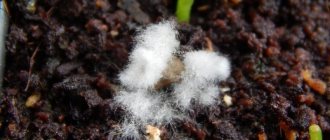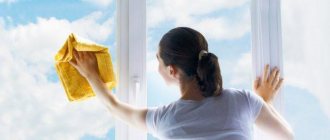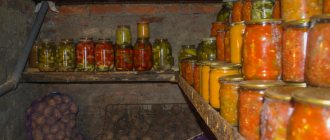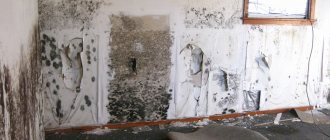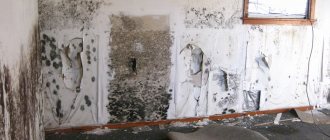Scientific evidence shows that mold appeared 200 million years ago and is constantly accompanied by humans. Its presence can be found everywhere: in the air we breathe, on the walls of our apartments, on products.
The beneficial properties of this substance cannot be diminished. It is used in the production of antibiotics and some sausage and cheese products. But this is only true for some species. Mold formations often cause harm to health. Black mold in the apartment is especially dangerous.
Let's get to know each other better: what is mold?
This is a fungus with a microscopic structure. Despite its simplicity, it has many cells that form long threads - hyphae. The microorganism reproduces through spores. They are constantly present in the air, but are in a calm state. Their activation begins as soon as they find themselves in favorable conditions for development. The main goal of a colony of microorganisms is to grow on the surface in different directions with the need to absorb as many nutrients as possible.
Let's talk about types
In mycology (the science of mushrooms) there are many classifications based on various characteristics. The simplest method of differentiation is by color. According to it, mold can be:
- Black. Forms in the form of spots. Can be found on walls near balconies or windows, on products. Consists of different groups of microorganisms. The most dangerous is aspergillus. Often causes allergies upon contact with skin or intestinal upset when ingested.
- Green. These are ascomycetes. Present on stone surfaces, bakery products and fermented milk products, vegetables. They multiply very quickly. Dangerous for people with reduced immunity.
- White (mukor). These are zygomycete fungi. They can settle on walls, delicacies (bread and cheeses), and in flower pots. Outwardly they resemble cotton wool. They are considered not too dangerous, but can cause gastrointestinal problems, headaches, and skin rashes.
- Yellow. Found on rice, fish, nuts, and liver. Releases aflatoxin. This is a strong carcinogen that can provoke the development of liver cancer or pneumonia.
- Gray. Saprophytic mushrooms look like a grayish coating. Capable of occupying any surface: fabric, paper, plastic, wood, stone. They also attack food and are easily transmitted through flower seeds. It is problematic to withdraw.
The pink and blue species are considered the most harmless. The first can be seen on rotten plant products. The second is in the trees. It is used in the production of gourmet cheeses. Both types do not appear in the apartment.
The main places of localization of the fungus
For mold to occur, special conditions are required. Places most suitable for its appearance:
- Wet areas. The higher the humidity, the faster colonies of fungi will appear there.
- Rooms with temperature changes. Temperature fluctuations cause condensation to form. This is a favorable environment for mold growth.
- Space with poor air circulation: pantry, cellar, dressing rooms.
- Unsealed or loosely sealed food. Mold “loves” vegetables and fruits with a high content of sugar and acid: citrus fruits, peaches, apples, homemade pickles. Can form on porous products - bread, cottage cheese.
Look for the uninvited guest on the walls and ceilings of kitchens, bathrooms, under window sills, behind cabinets, even between the pages of books in damp areas. If it's not there, you can calm down. It is unlikely that the fungus is localized anywhere else.
What mold should you be wary of?
There are more than 200,000 types of mold in the world and approximately 25% of the total are dangerous to humans, and this is about 50,000 species - an impressive number.
Under no circumstances should you eat food that is already moldy. Even if you decide to cut off the part that visually appears in the form of plaque, you need to understand that the entire product is permeated with mycelium (the root system of mold) and harmful substances will certainly enter the body. This applies to any food products, with the exception of those in the production of which the so-called noble mold was used (cheeses, wines, etc.). Products that are affected by fungus should be disposed of immediately.
No less dangerous is the mold that develops on the walls; it can be of different colors - gray, black, green, white. During the process of reproduction, a huge amount of spores and microtoxins are intensively and regularly released into the air, which can lead to respiratory diseases, a weakened immune system, and diseases of the lungs, kidneys, liver, heart and other organs.
If a mold grows on a houseplant, it destroys the flower; if the fungus grows in a greenhouse, the entire ecosystem may die.
Return to content
Causes of mold
It is imperative to combat mold in the apartment. But you can’t calm down by removing visible growths. First, we need to eliminate the conditions for its occurrence and find out the reasons. This unpleasant phenomenon is usually caused by:
- Excess moisture leading to high humidity. An indicator exceeding 80% is considered dangerous. Dampness in the room can cause leaks in the roof and pipes.
- Formation of condensation. It easily penetrates into cracks between facing materials, into the porous surface of ceilings and walls. And along with the steam, fungal spores also get there.
- Lack of sun rays. The problem is relevant for residents of the northern regions due to short annual insolation. Some rooms (bathrooms, storage rooms) do not have windows. Mold feels safe in them. After all, its main enemy is ultraviolet radiation.
- Impaired air exchange. With good ventilation there are no conditions for the development of microorganisms. In rooms with limited air movement, mold can almost always be found. Stagnation of air masses can be associated with malfunctions of air conditioning and supply and exhaust ventilation systems. They need to be periodically cleaned and disinfected.
- Lack of antiseptic treatment. During construction and repairs, antiseptics are not always used. This negatively affects the microclimate and increases the likelihood of fungus occurrence to 98%.
Other factors can also contribute to the appearance of mold: freezing of walls, proximity to groundwater (typical of private houses), disturbances in the heating system. The end rooms are the first to suffer from mold growth. High-quality thermal insulation and the use of additional heating devices can correct the situation.
How to reduce humidity
First of all, you need to determine what is the source of excess moisture. Where mold appears can indicate the cause of its appearance.
The bathroom is a high-risk area . Most often, this is where the first signs of infection appear. High humidity in this room is natural, and ventilation may be insufficient.
What should be done. Reducing humidity is simple: you need to wipe the walls of the bathtub and shower stall from water droplets, and dry towels and bathrobes on the balcony or in the dryer. Use forced exhaust ventilation and always turn it on after using the bathroom, or at least leave the door open for at least half an hour for ventilation.
Mold is found on the wall where communications pass : cold and hot water pipes, sewerage. Leaks are possible, often even unnoticeable, the wall constantly gets wet. Sometimes moisture condenses on cold water pipes and drips from them.
What should be done. Leaks need to be found and fixed, old pipes replaced. Use thermal insulation for pipes, although a more effective way is to reduce humidity
Often on the first floors of buildings or in a private home, mold appears on the floor, under the floor, behind the baseboards, or covers the corners with gray stains. The reason is dampness coming from the basement , the house has poor waterproofing, perhaps there are water or sewer leaks in the basement.
What should be done. Check the basement to see if there is excess moisture there or if pipes are leaking. Making good waterproofing is not so easy, but if this is the only way to get rid of dampness and mold, you have to do it.
Mold quite often affects the wall of the apartment that goes outside . This wall is colder than the others, even if it is impossible to determine this by touch. It is often raw. It is likely that there is a gap in the wall and rainwater is flowing in there. In some cases, the problem is that water is leaking from the roof down the wall due to clogged drains. In winter, it freezes and moisture condenses on the cold surface from the inside.
What should be done. Tidy up the wall. This is difficult; industrial climbers are needed if the apartment is not on the first floor.
If mold appears everywhere, plaque can be found in different places, and there is an unpleasant smell in the apartment, then the reason is probably that the humidity is constantly high . The amount of water vapor is high in a house where there are many tropical plants or aquariums where laundry is boiled and dried indoors.
Constantly drying diapers and daily wet cleaning is a typical picture for a home with a small child. And even with all this, they often don’t open the windows so as not to catch a cold in the baby! Mold is a frequent guest in such houses. And if the baby's parents follow the recommendations to use a humidifier without bothering to find out whether the amount of water vapor is normal, then mold will soon be everywhere.
What should be done. It is necessary to eliminate sources of high air humidity or provide good forced ventilation.
Mold in the apartment: why is it dangerous?
Colonies of fungi on walls, ceilings, and cabinets are often compared to a time bomb. Their appearance signals danger. Initially, mold formations do not have a negative impact on health. But prolonged contact with them leads to serious troubles, since most species have pathogenic forms.
The consequences of mold growth are sad: it releases carbon dioxide, essential oils, and new spores into the air. This provokes the development of various pathologies. Among them:
1. Dermatoses and mycoses. They are characterized by skin lesions of varying severity due to the settling of fungal spores on them. 2. Chronic diseases that cause irritation of the mucous membrane. This is how a constant runny nose, dry cough, and conjunctivitis arise. 3. Joint and rheumatic diseases. A person feels weakness in the limbs, drowsiness, headaches, and general health worsens. 4. Lesions of the upper and lower respiratory tract. This can cause the development of bronchitis or pneumonia. 5. Activation of cancer cells, leading to the appearance of malignant tumors. 6. Intoxication of the body as a result of spores entering the digestive tract. Expressed by diarrhea or constipation, nausea, vomiting, abdominal pain. 7. Allergic reactions. The appearance of skin rashes, itching, swelling.
You should understand: cleanliness in the apartment is not decisive for mold. According to research by Russian microbiologists, even in rooms with exemplary order, 1 cubic meter of air contains up to 500 fungal spores, which cause the greatest harm to the body. To protect yourself from unpleasant consequences, you need not only to periodically clean, but also to eliminate favorable conditions for the development of microorganisms, that is, maintain optimal humidity and temperature conditions, and create conditions for unhindered air circulation.
Who is guilty
What to do if mold appears on the wall? Where should you go first? First you need to determine whose fault it was formed. Subsequent actions will depend on this.
Residents
The main reason influencing the appearance of fungus may be too much load on the apartment with household needs, namely cooking, violation of ventilation rules, too frequent washing, etc. In this situation, residents will have to eliminate mold themselves.
Neighbours
Sometimes a violation of the temperature and humidity conditions in a neighboring apartment can cause the spread of fungus to neighboring rooms. Who should remove mold if it appeared due to the fault of neighbors?
In this case, you will have to contact the management company .
She must record the fact of violation and draw up a special act. You can also invite an employee of an appraisal company to determine the amount of damage. In the future, you can ask your neighbors to verbally compensate for the damage caused or send a letter of notification. If they refuse to compensate for the damage caused to property, it is necessary to file a statement of claim with the judicial authority .
Read also: At what temperature will the heating be turned on?
Management Company
Maintenance of common property in accordance with the Housing Code of the Russian Federation is carried out by a management company. If there is a violation in the sealing of seams, poor waterproofing, broken gutters, as well as weak heating, which can provoke the formation of mold, then she is responsible for this.
How to get rid of mold in the bathroom?
The bathroom is one of the suitable places for the localization of mold fungi. Black spots of varying sizes can often be seen in corners, on ceilings and walls. They cannot be ignored. Use the standard algorithm of actions:
- Determine the depth of the growth. When black spots are located on the surface, they can be easily removed mechanically. If mold penetrates under the plaster or facing tiles, get ready for repairs.
- Examine the room for the extent of the damage. Check not only visually noticeable areas - sink, faucet, bathtub. Pay attention to heated towel rails, seams between tiles, and the space under the bathtub.
- Eliminate the causes of mold: leaking taps, poor operation of the hood.
- Clean the affected area mechanically. You can use industrial or folk remedies.
- Carry out antiseptic treatment.
Eliminating fungal colonies is only getting rid of half the problems. It is important to prevent their occurrence in the future. This can be achieved by regularly checking the condition of surfaces. In order not to create an environment favorable for microorganisms, you need to avoid drying clothes in the bathroom and taking water procedures with a lot of steam. Installing a “warm floor” will also help. With it, surfaces will dry faster.
Where did the mold come from?
Molds of the penicillium and cladosporium families often inhabit apartments and houses.
Many experts explain the almost widespread contamination of walls with mold by the fact that very cheap insulation materials were used in the construction of housing. For example, polystyrene foam.
Mold is tenacious and multiplies quickly in high humidity. It feels good on plaster, plastic and wood.
Mold fungi are very insidious with their toxins, which simply poison the human body. Those who have mold in their house often complain of allergies, constant headaches, asthma, and rhinitis. And some weakened people even have mold infections of internal organs. As a rule, all diseases caused by mold are very difficult to treat and often become chronic.
Insidious mold spreads quickly through the air, and it does this most actively in the fall.
Mold on the walls in the apartment: how to get rid of it?
You need to start fighting this unpleasant phenomenon as soon as you notice it. Mold grows quickly and can grow through plaster to brick and concrete within a year. Then it will be even more difficult to remove it, and constant proximity to it is harmful to health, leads to damage to furniture, and reduces the aesthetics of the room.
It is necessary to combat mold lesions in a comprehensive manner:
- Clean the affected surface mechanically. It must first be moistened generously with water to prevent the spores from spreading to other areas.
- Treat the cleaned area with an antifungal agent, going beyond its boundaries. There may also be disputes there. It is necessary to prevent the development of mycelium.
- Dry the surface and ventilate the room.
When processing, safety precautions must be observed. It is necessary to work in long sleeves, gloves and a respirator. After disinfection, the room must be left for several hours (the time depends on the product used). Upon returning to it, the room should be ventilated.
It is advisable to throw away things affected by the fungus. This will prevent the reappearance of microorganisms.
Stages of cleansing
If you decide to cope on your own, then get ready for serious work. Deliverance occurs in three stages.
- Eliminating the causes of occurrence - we talked about them above.
- Cleaning affected areas.
- Treatment with cleaning and disinfecting compounds.
After the attack is defeated, it makes sense to wait and make sure that the rot does not attack again. Only after this can you begin repairs.
Plaque removal
This is where the fun begins: the cleanup. Whether the fungus will return to your home depends on how well it is carried out. And even if you have eliminated all the factors contributing to the development of plaque, treated and dried the surface, but missed an infected piece of plaster, then wait: as soon as more or less suitable conditions appear, the walls will turn black.
Therefore, we do not spare materials: it is better to do everything thoroughly once and live in peace.
- We remove all the wallpaper in the room to assess the extent of the damage.
- We remove all building material, even brick or concrete. It is necessary to remove layers of plaster not only in the place where there is direct darkening, but also around it with a decent margin.
- The hard base needs to be cleaned with a brush and carefully walked over it with sandpaper.
By the way, at all stages where direct contact with rot occurs, you should keep a spray bottle of water on hand to wet the surface. This will reduce the spread of spores throughout the room.
After mechanical cleaning, you can begin chemical etching.
Mold control methods
You have to choose what you can use to remove plaque and disinfect the walls: improvised compounds or chemicals.
No matter what anyone says about the miraculousness of “grandmother’s” recipes, special chemistry is still more reliable. It is guaranteed to eliminate the problem with the minimum possible expenditure of time and effort.
The savings argument is irrelevant here. Saving several hundred or thousand rubles can later result in new repairs and serious health problems.
However, folk recipes should not be completely forgotten. They are good as an additional and preventive remedy.
Folk remedies
To be sure to remove the problem, treatment with any cleaner will have to be carried out several times.
If the consistency of the substance allows, then it is best to apply it from a spray bottle: this way there is less risk of leaving untreated areas. For thicker compositions, you can use a brush or sponge, carefully covering the entire surface.
Effective control tools include:
- Copper sulfate
It is called one of the most effective remedies among “homemade” compounds. From copper sulfate powder you need to prepare a solution in the following proportions: 20–30 g of powder per 1 liter of water.
The mixture is applied to the defective areas and left to dry for 3-4 hours.
For particularly advanced cases, you can use a solution based on vinegar essence. You need to dissolve half a kilo of vitriol in two liters of vinegar and walk along the walls.
Some people recommend adding 1 tsp to wallpaper glue when making repairs. vitriol for prevention.
- Borax
Borax is non-toxic and therefore can be used in residential areas without fear.
Dissolve 1 cup of borax powder in 2.5 liters of water. This cleaner needs to be applied to areas where blooms have accumulated and left for a few minutes, then washed off with a brush.
- Alcohol-containing products
Any liquid with a “degree” of high strength is suitable here: vodka, ammonia or salicylic alcohol.
Ammonia must be diluted in water in a 1:1 ratio. There is no need to dilute the remaining substances: they can be applied in their pure form. The liquid should be applied to the treated areas and wait about an hour, after which the room should be well ventilated to eliminate the pungent odor.
- Potassium permangantsovka
Potassium permanganate can remove mold and protect against its reappearance. To prepare the solution you will need to mix 1 tsp. powder and 1 liter of water. Cover the affected area with this mixture and leave until completely dry.
- Chlorine-containing compounds
This is the well-known Whiteness, Domestos and other similar chemicals. They are spread on the wall without prior thinning and left for 30–40 minutes. After this, the plaque must be cleaned with a brush, and the product must be washed off carefully.
Many people recommend this method.
- Furacilin
The liquid sold in the pharmacy will not work: the concentration of the active substance is too small. You can make an effective solution yourself from 10 crushed furatsilin tablets and 1 glass of water.
It will be useful to periodically treat window sills, floors and doors with an antiseptic made from 5 liters of water and 1 tablet. This will prevent the development of rot.
- Soda
More suitable for removing unpleasant odors that often accompany fungal growth. You need to prepare a slurry from soda and water and coat all surfaces that exude a putrid aroma with it. After an hour, the mixture can be washed off.
Specialty chemistry
Since we vote for the use of special formulas, we will name several effective means for breeding flowers at home:
- San Klin;
- Alpa Fongifluid;
- Savo;
- Bagi Anti-Mold;
- Pufas Amss;
- HG Mold Spray;
- Prosept;
- Sion;
- Feidal Schimmel EX.
The drug should be selected based on the material you will be treating and the area of damage.
Each of these products has its own method of application and exposure time. Therefore, before applying, be sure to read the instructions, which tell you how to get rid of the misfortune, and strictly adhere to these recommendations.
You can buy antiseptics and cleaners in the household chemicals department of the supermarket, hardware stores, and online hypermarkets, for example, on Ozon.
How to treat mold in an apartment?
Hardware stores sell spray cans. These fungicidal drugs destroy fungal spores and inhibit the proliferation of microorganisms. But they are toxic chemicals. Their use is unsafe if there are children, elderly people, or animals in the house. Experts recommend using fungicides in extreme cases when other options have not helped.
An effective remedy for mold in an apartment is bleach. It copes with different types of mushrooms. But it is suitable for tiles, glass, that is, non-porous substrates. Materials with a porous structure will absorb liquid matter. This will negatively affect the condition of the product and its appearance.
Essential oils are completely safe. They are expensive, but their consumption is economical. The bottle is enough to treat the entire apartment. Oils from grapefruit seeds, tea tree, rosemary and lavender are especially valued. After using them in the bathroom, you can shower no earlier than 12 hours.
Folk methods of struggle
Every housewife has several recipes in her arsenal that are passed down from generation to generation. Office glue, copper sulfate, and vinegar help a lot. You can prepare several solutions that destroy mold:
- Dissolve 2 liters of vinegar and 0.5 kg of copper sulfate in 10 liters of water.
- For 10 liters of water you will need 0.4 kg of boric acid, 0.9 kg of borax and 1.4 liters of table vinegar.
- Take 4 parts water, 2 parts each hydrogen peroxide and vinegar, 1 part boric acid.
Solutions must be applied by spraying or using a brush.
Using baking soda and vinegar gives good results. First, sodium carbonate is applied to the mold-affected area. Then vinegar is poured on top. The resulting foam easily penetrates porous materials and removes mold.
Using professional methods to eliminate mold
If mold does appear in the house, you need to contact a professional. We, the sanitary and epidemiological service “Dezcenter-Rus”, will solve your problem with an effective modern method.
a specialist removes mold from a wall
mold stains
Microwave drying
The main enemies of mold are heat and dryness. You can get rid of mold on the walls in your apartment using microwaves - ultra high frequencies.
This method involves heating the walls to a depth of 25-35 cm to 65-70 degrees. When exposed to high temperatures, mold spores die almost immediately.
The advantages of the microwave method are as follows:
- high efficiency – up to 99%;
- no need to use chemicals;
- mold dies instantly;
- impact on deep and hard-to-reach areas;
- can be used on any surface;
- safety for human health.
There is no safer or more effective alternative to microwaves. We know how to get rid of mold on walls in just one procedure. Mold on the walls of the house will cease to be a problem if you approach it wisely. The only important thing is timely prevention and trust in a specialist.
This slideshow requires JavaScript.
Briefly about prevention
It is very easy to prevent fungal colonies from establishing themselves in your home. It is necessary to ventilate the room daily in the morning and evening. Carry out timely repairs of air conditioners and humidifiers. Monitor indoor humidity levels. The Airnanny A7 multifunctional ventilation system will help with this. It traps and destroys mold, harmful gases, viruses, maintains optimal humidity and temperature values, and provides ventilation with the windows closed.
Forget about mold forever! If you follow preventative measures, this will not be difficult. Let your home have coziness and a comfortable microclimate.
Why does mold appear?
Let's consider three prerequisites for the appearance of fungus:
- Presence of mold spores in the air. They can get into the house with air flow, through things, products, or animals;
- Feeding organic medium: paper, wood, stone, concrete, dirt, peat, as well as soil in pots of indoor plants, etc.;
- A climate suitable for growth and reproduction. Namely:
- Temperature about +20°C, humidity – 70-90%;
- Uneven heating in the room and poor performance of the ventilation system.




